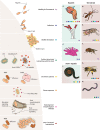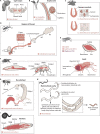How It All Begins: Bacterial Factors Mediating the Colonization of Invertebrate Hosts by Beneficial Symbionts
- PMID: 36301103
- PMCID: PMC9769632
- DOI: 10.1128/mmbr.00126-21
How It All Begins: Bacterial Factors Mediating the Colonization of Invertebrate Hosts by Beneficial Symbionts
Abstract
Beneficial associations with bacteria are widespread across animals, spanning a range of symbiont localizations, transmission routes, and functions. While some of these associations have evolved into obligate relationships with permanent symbiont localization within the host, the majority require colonization of every host generation from the environment or via maternal provisions. Across the broad diversity of host species and tissue types that beneficial bacteria can colonize, there are some highly specialized strategies for establishment yet also some common patterns in the molecular basis of colonization. This review focuses on the mechanisms underlying the early stage of beneficial bacterium-invertebrate associations, from initial contact to the establishment of the symbionts in a specific location of the host's body. We first reflect on general selective pressures that can drive the transition from a free-living to a host-associated lifestyle in bacteria. We then cover bacterial molecular factors for colonization in symbioses from both model and nonmodel invertebrate systems where these have been studied, including terrestrial and aquatic host taxa. Finally, we discuss how interactions between multiple colonizing bacteria and priority effects can influence colonization. Taking the bacterial perspective, we emphasize the importance of developing new experimentally tractable systems to derive general insights into the ecological factors and molecular adaptations underlying the origin and establishment of beneficial symbioses in animals.
Keywords: animal-microbe interactions; beneficial bacteria; host colonization; molecular factors; symbiosis.
Conflict of interest statement
The authors declare no conflict of interest.
Figures


Similar articles
-
Endosymbionts of Metazoans Dwelling in the PACManus Hydrothermal Vent: Diversity and Potential Adaptive Features Revealed by Genome Analysis.Appl Environ Microbiol. 2020 Oct 15;86(21):e00815-20. doi: 10.1128/AEM.00815-20. Print 2020 Oct 15. Appl Environ Microbiol. 2020. PMID: 32859597 Free PMC article.
-
Motility-Independent Vertical Transmission of Bacteria in Leaf Symbiosis.mBio. 2022 Oct 26;13(5):e0103322. doi: 10.1128/mbio.01033-22. Epub 2022 Aug 30. mBio. 2022. PMID: 36040028 Free PMC article.
-
A strong priority effect in the assembly of a specialized insect-microbe symbiosis.Appl Environ Microbiol. 2024 Oct 23;90(10):e0081824. doi: 10.1128/aem.00818-24. Epub 2024 Sep 18. Appl Environ Microbiol. 2024. PMID: 39291984 Free PMC article.
-
Common trends in mutualism revealed by model associations between invertebrates and bacteria.FEMS Microbiol Rev. 2010 Jan;34(1):41-58. doi: 10.1111/j.1574-6976.2009.00193.x. FEMS Microbiol Rev. 2010. PMID: 19909347 Free PMC article. Review.
-
Versatile and Dynamic Symbioses Between Insects and Burkholderia Bacteria.Annu Rev Entomol. 2020 Jan 7;65:145-170. doi: 10.1146/annurev-ento-011019-025025. Epub 2019 Oct 8. Annu Rev Entomol. 2020. PMID: 31594411 Review.
Cited by
-
Origin and function of beneficial bacterial symbioses in insects.Nat Rev Microbiol. 2025 Sep;23(9):551-567. doi: 10.1038/s41579-025-01164-z. Epub 2025 Mar 27. Nat Rev Microbiol. 2025. PMID: 40148601 Review.
-
A case study assessing the impact of mating frequency on the reproductive performance of the Hawaiian bobtail squid Euprymna scolopes.Lab Anim Res. 2023 Jul 28;39(1):17. doi: 10.1186/s42826-023-00168-1. Lab Anim Res. 2023. PMID: 37507806 Free PMC article.
-
Genomic evidence for flies as carriers of zoonotic pathogens on dairy farms.NPJ Biofilms Microbiomes. 2025 Jun 19;11(1):111. doi: 10.1038/s41522-025-00685-y. NPJ Biofilms Microbiomes. 2025. PMID: 40537478 Free PMC article.
-
Quorum sensing inhibits interference competition among bacterial symbionts within a host.Curr Biol. 2023 Oct 9;33(19):4244-4251.e4. doi: 10.1016/j.cub.2023.08.051. Epub 2023 Sep 8. Curr Biol. 2023. PMID: 37689064 Free PMC article.
-
Ecology and evolution of the social microbiome.Annu Rev Ecol Evol Syst. 2024;55(1):89-114. doi: 10.1146/annurev-ecolsys-102622-030749. Epub 2024 Aug 1. Annu Rev Ecol Evol Syst. 2024. PMID: 40678272 Free PMC article.
References
Publication types
MeSH terms
LinkOut - more resources
Full Text Sources

